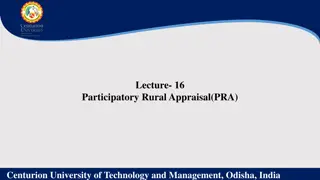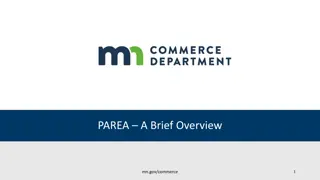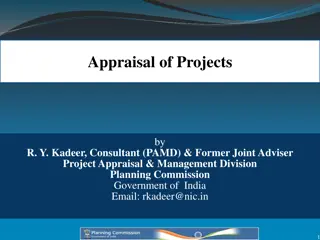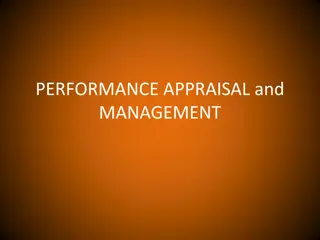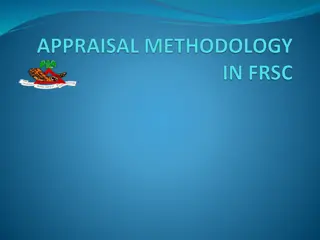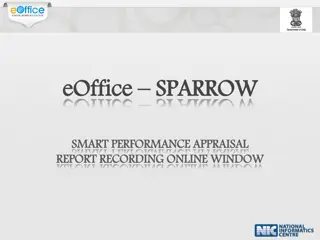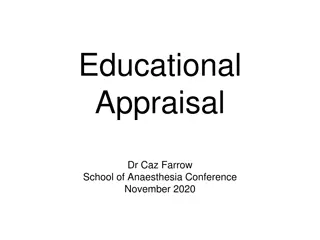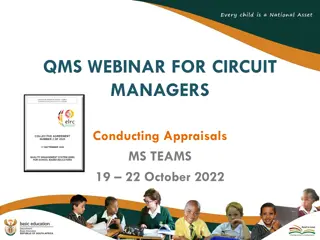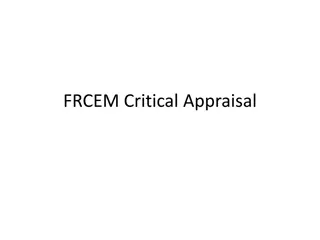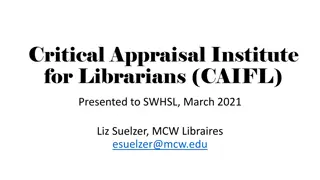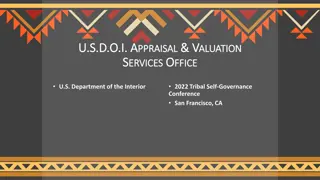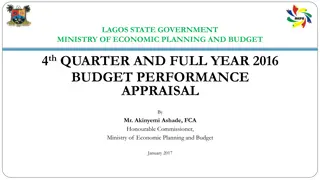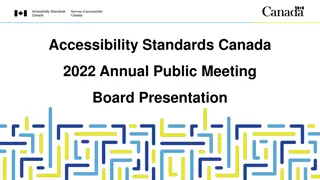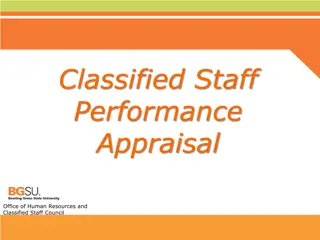Insights into Canada and the Appraisal Institute of Canada
Canada, the second largest country in land mass, has a population of over 40 million with a density of 4 per km². The Appraisal Institute of Canada, a national association, advocates for its members, sets professional standards, and offers designation education. Their AACI and CRA designations are highly regarded in the real property valuation profession.
Download Presentation

Please find below an Image/Link to download the presentation.
The content on the website is provided AS IS for your information and personal use only. It may not be sold, licensed, or shared on other websites without obtaining consent from the author. Download presentation by click this link. If you encounter any issues during the download, it is possible that the publisher has removed the file from their server.
E N D
Presentation Transcript
A Word or Two about Canada Canada is the second largest country in the world in terms of land mass just under 10 Million Km2 In 2023, the population was estimated at just over 40 million. Canadian population is equivalent to c. 0.5% of the total world population. Canada ranks number 38 in the list of countries (and dependencies) by population. The population density in Canada is 4 per Km2 2
Geography and Habitation Canada s population is largely concentrated in major centres most of which are within a 4 hour drive to the US border Major population centres / markets include: Toronto / GTA Montreal Vancouver / GVA Calgary Edmonton Ottawa / NCR This Photo by Unknown Author is licensed under CC BY-SA 3
Appraisal Institute of Canada National not-for-profit association with headquarters in Ottawa established 85 years ago. Current staff count is 14 full-time with some functions (professional practice related) being addressed by contract arrangements with members. Membership approximately 5,500 estimated to be approximately 80% to 85% of the overall appraiser / valuer population. Federally incorporated under the Canada Corporations Act as in1960 now under the Canada Not for Profit Corporations Act Ten affiliated provincial associations (10) each independent legal entities each incorporated separately under provincial acts 5
AIC Plays a Multi Phased Role Advocate for Members Dealing with Federal and Provincial Regulators Promoting their services. Stakeholder engagement Publish Professional Standards AIC has published CUSPAP for over 20 years Self Regulatory Body Public Protection Discipline of Members. Designation Education and training in partnership with leading Canadian universities. The challenge - Balance and deliver on of all those roles/responsibilities. 6
AICs Position in the Marketplace AIC s designations (AACI / CRA) are recognized as the leading credential for real property valuation professionals. AACI and CRA designations both require a university degree and the courses of study are delivered through the University of British Columbia and Universite Laval. Members must complete all of their work in accordance with CUSPAP standards. CUSPAP is a rigorous document aligned well with EVS, USPAP and IVS This combination positions AIC and our members as the preeminent body and the top professionals in our space. 7
Canadas Housing Market 8
Canadas Housing Market Canada s housing market is a misnomer it is a consolidation of a very diverse set of local markets across the country. One need look no further than to review average house prices in Canada. In Canada, an average house is normally 2500 sq ft 230 sq metres. According to the Canadian Real Estate Association, the average house price in August 2023 was: Toronto / GTA (population 7 million) - $1,141,4000 CAD Greater Montreal (population 4.3 million) - $521,600 CAD Vancouver / GVA (population 2.7 million) - $1,208,400 CAD Greater Calgary (population 1.6 million) - $553,800 CAD Greater Edmonton (population 1.5 million) - $397,811 CAD Ottawa / NCR (population 1.4 million) - $649,800 CAD One CAD is roughly .7 Euros 9
Is it a Bubble? The question of whether or not the Canadian housing market is a bubble is never too far out of the minds of governments and media. Housing affordability has recently become the number one issue of concern for all of the Canadian federal political parties and will no doubt be a top issue when Canadians go to the polls in 2025. The range of opinions on this question vary as widely as house prices or the weather. 10
Whats Driving Up Prices? Canada s housing market is a victim of steadily increasing demand and stagnant supply. Demand is driven by: Household formation Immigration Strong employment numbers Supply has been constrained by: High costs and complex procedures for development Restrictive regulations on land use High costs of construction shortage of labour COVID exacerbated both sets of pressures 11
Canadas Regulatory Landscape 12
Key Marketplace Factors Canada s banking system has been seen as a very stable player on the global market for a number of years Canada emerged quickly from the global financial crisis and saw no lasting damage. Canada s housing market saw a sharp rise during the pandemic - while this is not new for markets like Toronto and Vancouver this rise was much more widespread. In early 2022 the Bank of Canada began raising interest rates which has clearly cooled the market but higher rates have been a key driver of inflation as mortgage payments have increased and affordability is suffering. Sales activity is down across the country prices are declining but, in most markets, still remain above pre- pandemic levels. 13
Indebtedness and Affordability The political debate in Canada right now is largely focused on housing affordability and indebtedness. What is clear is that mortgage indebtedness has risen as a result of higher housing prices and higher mortgage rates. The challenge for Canadian regulators is that the bulk of of mortgage lending is under the auspices of federal regulators but some of the key drivers of supply fall under the jurisdiction of provinces and in some cases the cities. AIC has been lobbying for a multi-level approach (governments at all levels - along with the housing industry) to collaborate on solutions to address these issues. 14
Mortgage Lending OSFI is responsible for regulating the activities of just under 100 Canadian based mortgage lenders the Federally Regulated Financial Institutions (FRFI). OSFI regulated lenders underwrite approximately 65% to 70% of the residential mortgage lending market. Regulations require lenders to take a risked based approach to mortgage underwriting loans with LTV above 80% must be insured through third party insurers.. Lenders are required to have a systematic approach to the valuation of collateral including appropriate numbers of valuations prepared by external qualified professionals - and assessments of the borrowers capacity and willingness to repay. The regulatory approach taken by OSFI is one of the main factors credited for the stability of Canada s real estate market. Default rates for OSFI regulated lenders have historically hovered around .25%. 15
Canadians are Conservative It is important to acknowledge the reality that Canadians tend to be somewhat more conservative and risk averse in their approach particularly in comparison to Americans. Mortgages are not offered on a no recourse basis borrowers cannot discharge their obligations by simply surrendering the collateral. This results in a cautious conservatism for the bulk of mortgage lending. Conservatism flows through to the regulations around lending as legislators, regulators and lenders tend to take a similar tack and approach. 16
What About Prudent Value Canadian regulators have placed the burden for determining the appropriate value for lending purposes on the lender as opposed to the appraiser. To ensure that the value of the property is appraised in a prudently conservative manner, the valuation must exclude expectations on price increases and must be adjusted to take into account the potential for the current market price to be significantly above the value that would be sustainable over the life of the loan. In addition, institutions should assess and adjust, as appropriate, the value of the property for the purposes of calculating the LTV by considering relevant risk factors that make the underlying property more vulnerable to a significant house price correction or that may significantly affect the marketability of the property. If a market value can be determined, the valuation should not be higher than the market value. 17
Risk and Reward Lenders receive the reward for their investments in the mortgage finance marketplace. Philosophically, it seems logical that those that receive the reward should assume and manage the risks associated with the investments. Canadian regulators are focused primarily on the solvency of our lenders and in ensuring their risk management actions protect that solvency. 18
The Test of Time OSFI s approach to regulating the market has proven itself to be sound over time and needs to continue. Default rates have been very low for decades and while there are some concerns those could increase as a result of higher interest rates those are offset by strong employment numbers. The combination of sound valuation fundamentals and assessing the borrower s creditworthiness are essential elements and should form the foundation of the mortgage underwriting process. 19
The Impact on the Profession 20
Regulation Affects Market Conduct As a result of regulation, Canada s mortgage lenders must maintain a strong focus on risk management which has included collateral valuation. Marketplace has been seeking faster and cheaper options as an alternative to full appraisals. While Automated Valuation Models have emerged in the marketplace their use to date in lending transactions has been somewhat limited to lower risk (good credit score / low LTV / stable markets) mortgages. AIC has been lobbying to maintain market share and has been actively promoting full appraisals as the gold standard . 21
Threats to the Profession Given the current landscape, AIC does not see a threat as a result of erosion in legislative oversight. Governments are going to be reticent to loosen regulation at a time when indebtedness and affordability are such a concern. Advancements in technological approaches to valuation present a threat nothing is as good as a full appraisal but if and when technology can present something that is good enough it will negatively impact the profession. The challenge facing the profession and, by extension, the AIC - is to seek ways to adapt as and when this technology emerges to maintain relevance. 22
Other Concerns Demographics Canada s population is aging and AIC s membership is not immune to that trend. At the same time, less young people are entering the workforce and the rate of new entrants is not keeping pace with the demands across the labour market. Canada is looking to immigration to help fill the gap but that was slowed during COVID. The profession will also need to find ways to adapt to this new reality. 23
Closing Thoughts 24
Some Final Thoughts Canada s regulatory approach applicable to the bulk of the mortgage market has been highly successful. The approach has: Obligated lenders to take and to assume responsibility for a systematic approach to mortgage underwriting. Protected the importance of professionally prepared valuations and has required lenders to use them in appropriate cases. Placed the responsibility for determining the appropriate liabilities on the lenders as opposed to on the valuation profession. Taken together, it has served the housing market, Canadians and the valuation profession very well. 25
This Photo by Unknown Author is licensed under CC BY-SA-NC 27



